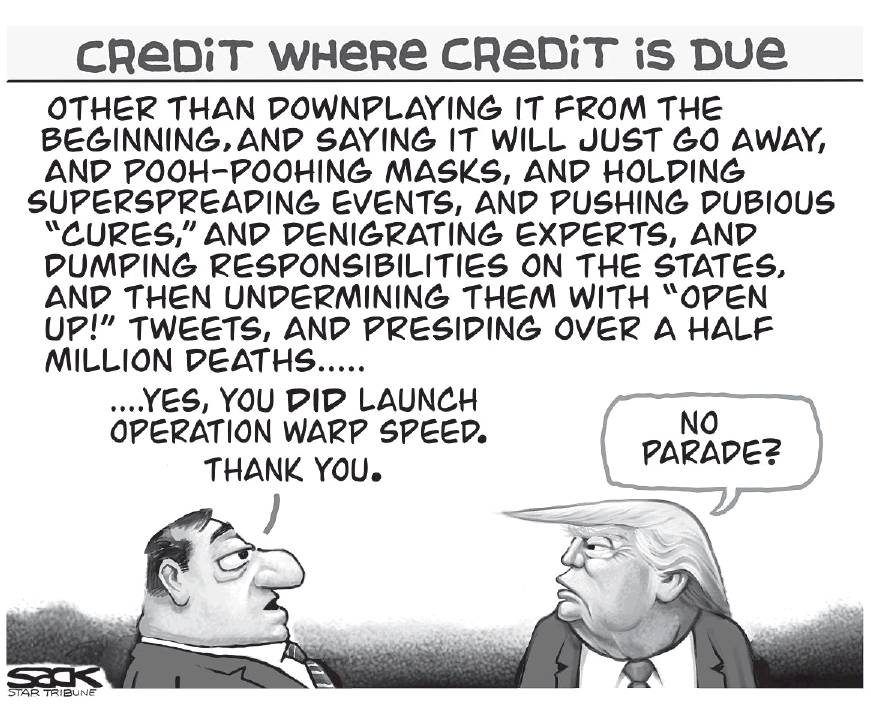|
Did Trump choose money over public health? Is Trump truthful and reliable? What's the worst thing Trump has done to the country? (As of April 17, 2019) (Oct 6, 2020) THE FULL STORY OF TRUMP & COVID: More than 7 million Americans have suffered from COVID-19, including Pres. Trump. Emmy winner Jeffrey Wright narrates the documentary detailing how four years of Trump's actions brought America to this moment (warning: distressing images).
This video, by Trevor Noah, was released in November 2020 portending actions yet to come centered around voter suppression. GEORGIA Skirmishes along the battle line flared repeatedly this week: March 2021 . . . At the Supreme Court, Republican and Democratic lawyers clashed over part of the landmark Voting Rights Act. A court ruling that would broadly define the reach of that law “puts us at a competitive disadvantage relative to Democrats,” attorney Michael Carvin, who represented the Arizona Republican Party, bluntly told the justices. “Politics is a zero-sum game,” he said. In Congress, the House on Wednesday night passed by 220-210 a bill that would set nationwide standards for federal elections — a major expansion of Washington’s authority that Democrats say is needed to protect voting rights against restrictions in Republican states. The Democratic effort aims to block bills in Republican-majority state legislatures that would limit mail-in voting, cut back on early voting, impose new voter identification requirements and take other steps that would make voting more difficult. In Georgia, for example, a bill moving through the Legislature would, among other things, wipe out a day of Sunday voting frequently used by Black congregations, drastically reduce the number of drop boxes available for voters to deposit ballots and impose criminal penalties on groups that give food or water to people standing in line to vote. People in Georgia, especially in largely Black communities, have “had to wait in extraordinarily long lines to vote, putting in an entire shift, eight hours, standing on their feet,” said Nsé Ufot, chief executive of the New Georgia Project. A law that would “criminally prosecute volunteers who are providing water and snacks,” she said, “is evil — evil and racist.” The New Georgia Project on Wednesday opened a campaign to pressure major companies based in Georgia, including Coca-Cola and Home Depot, to call on Republican Gov. Brian Kemp to veto the bill if it passes. Arguments over voting rules are not new to American politics. What is new is the intense focus coupled with sharp partisan division, which, especially on the Republican side, has made the issue a major campaign theme. Both parties describe their clash in near-apocalyptic terms. During House debate on Tuesday, Republican leader Kevin McCarthy of California said the Democrats’ bill would “put a thumb on the scale in every election in America so that Democrats can turn a temporary majority into permanent control.” Former President Donald Trump in a speech Sunday called the bill a “monster” that “must be stopped.” Democrats and voting rights advocates describe their cause with equal urgency. “We have a wave of restrictionist legislation being introduced across the country,” said Myrna Pérez of New York University’s Brennan Center for Justice. “People can dress it up in terms of fraud or security, but these things are lies or ruses or pretexts for preserving political power.” The Democrats’ control of the White House and both houses of Congress gives them a chance — a tenuous one because of their narrow majorities — to block state-based restrictions, at least for federal elections. Their effort to do so comes in two major pieces of legislation. The one voted on Wednesday, denominated as HR 1 to symbolize its priority, would set nationwide standards for federal elections, overriding state laws on every step of the process from voter registration to the final counting of ballots. The bill would require states to allow wide use of mail-in ballots, and it sets a minimum number of days for early voting. It would mandate that states automatically register citizens to vote when they apply for a driver’s license or certain government benefits unless a person opts out — a policy now in place in California and 18 other states. And it would restore voting rights nationwide to felons who have completed their terms, giving voting rights back to several million people. The nearly 800-page measure would also establish a national system of public financing of campaigns, which Democrats have long urged as a way to reduce the power of wealthy interests. And it would all but eliminate partisan gerry mandering of congressional districts by mandating that states move to independent redistricting commissions . A second bill, named after the late Rep. John Lewis of Georgia, would restore key provisions of the Voting Rights Act that the Supreme Court struck down in 2013. The House is expected to pass that this spring. Among Democratic activists, a widely shared view holds that unless Congress mandates such changes, Republicans’ power to gerrymander congressional districts coupled with new voting restrictions would give the GOP an unbeatable advantage in the 2022 elections and for years to come. Democrats have a two-year window to either pass laws to change the voting system or cede power for a decade, many Democratic activists say. The hangover from last year’s campaign and Trump’s insistent false claims that Democrats stole the election have fueled passions. Even before Trump, however, battles over voting had begun to intensify, in large part because of the unusual nature of current American politics. Since the 1990s, Republicans nationwide have rarely won a majority: GOP presidential candidates have gotten fewer votes than their opponents in seven of the last eight presidential contests, a historically unmatched streak. But Republicans’ strong support in rural America turns out to match up almost perfectly with parts of the U.S. system that limit majority rule — the Electoral College, the equal representation of small and large states in the Senate and the ability of elected officials in most states to control the drawing of election districts . That has allowed the GOP to exercise far more governmental power than its share of votes. In the Senate, for example, the 50 Democratic or allied independent senators represent almost 42 million more constituents than the 50 Republicans, as Ian Millhiser of Vox, the online news site, recently calculated by totaling state populations.
The U.S. is getting a third vaccine to prevent COVID-19, as the Food and Drug Administration on Saturday cleared a Johnson & Johnson shot that works with just one dose instead of two.
Health experts had been anxiously awaiting a one-and-done option to help speed vaccinations, as they race against a virus that already has killed more than 510,000 people in the U.S. and is mutating in increasingly worrisome ways. The FDA said J&J’s vaccine offers strong protection against what matters most: serious illness, hospitalizations and death. One dose was 85% protective against the most severe COVID-19 illness, in a massive study that spanned three continents — protection that remained strong even in countries such as South Africa, where the variants of most concern are spreading. “This is really good news,” Dr. Francis Collins, director of the National Institutes of Health, told the Associated Press Saturday. “The most important thing we can do right now is to get as many shots in as many arms as we can.” Shipments of a few million doses to be divided among states could begin as early as Monday. By the end of March, J&J has said it expects to deliver 20 million doses to the U.S., and 100 million by summer. J&J also is seeking authorization for emergency use of its vaccine in Europe and from the World Health Organization. Worldwide, the company aims to produce about 1 billion doses globally by the end of the year. On Thursday, the island nation of Bahrain became the first to clear its use. On Sunday, a U.S. advisory committee will meet to recommend how to prioritize use of the single-dose vaccine. And one big challenge is what the public wants to know: Which kind of vaccine is better? “In this environment, whatever you can get — get,” said Dr. Arnold Monto of the University of Michigan, who chaired an FDA advisory panel that unanimously voted Friday that the vaccine’s benefits outweigh its risks. Data is mixed on how well all the vaccines being used around the world work, prompting reports in some countries of people refusing one kind to wait for another. In the U.S., the two-dose Pfizer and Moderna shots were 95% protective against symptomatic COVID-19. J&J’s one-dose effectiveness of 85% against severe COVID-19 dropped to 66% when moderate cases were rolled in. But there’s no apples-to-apples comparison because of differences in when and where each company conducted its studies, with the Pfizer and Moderna research finished before concerning variants began spreading. NIH’s Collins said the evidence of effectiveness shows no reason to favor one vaccine over another. “What people I think are mostly interested in is, is it going to keep me from getting really sick?” said NIH’s Collins. “Will it keep me from dying from this terrible disease? The good news is all of these say yes to that.” Also, J&J is testing two doses of its vaccine in a separate large study. Collins said if a second dose eventually is deemed better, people who got one earlier would be offered another. The FDA cautioned that it’s too early to tell if someone who gets a mild or asymptomatic infection despite vaccination still could spread the virus. There are clear advantages aside from the convenience of one shot. Local health officials are looking to use the J&J option in mobile vaccination clinics, homeless shelters, even with sailors who are spending months on fishing vessels — communities where it’s hard to be sure someone will come back in three to four weeks for a second vaccination. The J&J vaccine also is easier to handle, lasting three months in the refrigerator compared to the Pfizer and Moderna options, which must be frozen. “We’re chomping at the bit to get more supply. That’s the limiting factor for us right now,” said Dr. Matt Anderson of UW Health in Madison, Wis., where staffers were readying electronic health records, staffing and vaccine storage in anticipation of offering J&J shots soon. The FDA said studies detected no serious side effects. Like other COVID-19 vaccines, the main side effects of the J&J shot are pain at the injection site and flu-like fever, fatigue and headache. The FDA said there is “a remote chance” that people may experience a severe allergic reaction to the shot, a rare risk seen with the Pfizer and Moderna vaccines. The vaccine has been authorized for emergency use in adults 18 and older for now. But like other vaccine makers, J&J is about to begin a study of its vaccine in teens before moving to younger children later in the year, and also plans a study in pregnant women. All COVID-19 vaccines train the body to recognize the new coronavirus, usually by spotting the spiky protein that coats it. But they’re made in very different ways. J&J’s shot uses a cold virus like a Trojan horse to carry the spike gene into the body, where cells make harmless copies of the protein to prime the immune system in case the real virus comes along. It’s the same technology the company used in making an Ebola vaccine, and similar to COVID-19 vaccines made by Astra Zeneca and China’s Can-Sino Biologics. The Pfizer and Moderna vaccines are made with a different technology, a piece of genetic code called messenger RNA that spurs cells to make those harmless spike copies. The AstraZeneca vaccine, already used in Britain and numerous other countries, is finishing a large U.S. study needed for FDA clearance. Also in the pipeline, Novavax uses a still different technology, made with lab-grown copies of the spike protein, and has reported preliminary findings from a British study suggesting strong protection. Still other countries are using “inactivated vaccines,” made with killed coronavirus by Chinese companies Sinovac and Sinopharm. “The big question mark still is, how long does protection last?” Dr. Johan Van Hoof, global head of vaccine research and development at Janssen Pharmaceuticals |
Archives
July 2024
|






 RSS Feed
RSS Feed